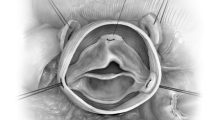Abstract
Role of root/valve preservation in aortic dissection and the relative merits and demerits of David procedure over Yacoub’s remodeling operation have been discussed in a one on one discussion with Dr. O.P. Yadava, Editor-in-Chief, IJTC and Dr. P Davierwala of Heart Center, Leipzig.
Similar content being viewed by others
Dr. Davierwala feels (Video) that in 70–80% of patients of Type A acute aortic dissection, aortic root can be preserved [1]. Patients in which it is difficult to preserve the aortic root are those with connective tissue disorders like the Marfans and Loey Dietz Syndrome, those with destroyed aortic root sinuses or with involvement of the coronary ostia or when the aortic root size is more than 45 mm [2]. He favors the David procedure over Yacoub’s remodeling operation in patients unsuitable for aortic root preservation and uses valve re-suspension as the commonest procedure for aortic root preservation. Dr. Davierwala warns against the use of bioglue in aortic dissection as it can cause tissue necrosis and instead advocates the use of GRF glue [3]. He also believes that recreation of the sinuses of Valsalva in acute aortic dissection is not necessary and quotes Tirone David’s experience of no difference in recurrent aortic incompetence or re-operations in patients undergoing aortic valve sparing procedures with or without creation of the neo-sinuses of Valsalva [4]. In valve conservation, he feels the valve morphology is very important and the coaptation length greater than 4 mm and an effective height of more than 8 mm is the main factor for longevity of repair and not just the absence of aortic regurgitation [5]. He finally issues a caveat that in patients with acute aortic dissection, surgeons not comfortable with aortic valve or root repair techniques must persevere with replacement as these patients are sick and would benefit from an expedient procedure.
References
Chiu P, Trojan J, Tsou S, Goldstone AB, Woo YJ, Fischbein MP. Limited root repair in acute type A aortic dissection is safe but results in increased risk of reoperation. J Thorac Cardiovasc Surg. 2018;155:1–7.
Hiratzka LF, Bakris GL, Beckman JA, et al. 2010 ACCF/AHA/AATS/ACR/ASA/SCA/SCAI/SIR/STS/ SVM guidelines for the diagnosis and management of patients with thoracic aortic disease: a report of the American College of Cardiology Foundation/American Heart Association Task Force on Practice Guidelines, American Association for Thoracic Surgery, American College of Radiology, American Stroke Association, Society of Cardiovascular Anesthesiologists, Society for Cardiovascular Angiography and Interventions, Society of Interventional Radiology, Society of Thoracic Surgeons, and Society for Vascular Medicine. Circulation. 2010;121:e266–369.
Suzuki S, Masuda M, Imoto K. The use of surgical glue in acute type A aortic dissection. Gen Thorac Cardiovasc Surg. 2014;62:207–13.
David TE, David CM, Feindel CM, Manlhiot C. Reimplantation of the aortic valve at 20 years. J Thorac Cardiovasc Surg. 2017;153:232–8.
Schäfers HJ, Bierbach B, Aicher D. A new approach to the assessment of aortic cusp geometry. J Thorac Cardiovasc Surg. 2006;132:436–8.
Author information
Authors and Affiliations
Corresponding author
Additional information
Publisher’s Note
Springer Nature remains neutral with regard to jurisdictional claims in published maps and institutional affiliations.
Electronic supplementary material
(MP4 31,039 kb)
Rights and permissions
About this article
Cite this article
Yadava, O.P., Davierwala, P. Root/valve preservation in aortic dissection. Indian J Thorac Cardiovasc Surg 35 (Suppl 2), 192 (2019). https://doi.org/10.1007/s12055-018-00787-7
Received:
Accepted:
Published:
Issue Date:
DOI: https://doi.org/10.1007/s12055-018-00787-7




